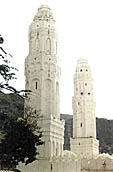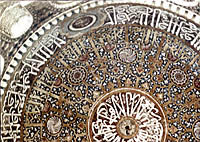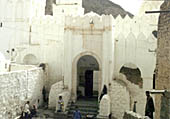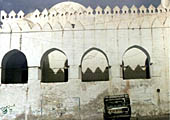
Ashrafya Mosque in Taiz Calls for Help [Archives:2000/16/Culture]
April 17 2000

The old antiquities of Bani Rasool Era are located in old Taiz, where we find Modafar and Ashrafya mosques, fragrance of history, relics of the era of different sciences, literature, and architecture.
When you reach Modafar mosque, you are sure to be astonished by the attractive design of that mosque. You cannot but remember Modafar Omar Bin Ali Bin Rasool who built that mosque in 600 Hegira. After getting the full view of the breath-taking MONUMENT, I proceeded towards Ashrafya mosque. When I looked at that mosque, I thought it a giant guard standing at a high hill taking-care of the magnificent Modafar mosque. The two minarets of that mosque form a wonderful view as they are standing in majesty and grandeur behind that mosque.

Had these ancient mosques with their beautiful variegations been in any other country, they would have paid them the attention they deserve and promote them into a major tourist attraction.

It is worth mentioning that the wife of king Ashraf, Jeha Attawashi Jamal’edden Matab Bin Abdullah Al-Ashraf built Matabya school, close to the Ashrafya mosque. This school is truly a symbolic expression of the revival of Bani Rasool Era. This school signals the prominent role of women during that golden era in the history of Yemen.
On the gate of the Ashrafya mosque, on its outer surface, there is an inscription on a stone which mentions the name of the architect who built the mosque and the date of its construction. The mosque was founded between the year 800 to 803 Hegira by King Ismail Bin Al-Abass Bin Ali Bin Dawod Bin Yosief Bin Omar Bin Ali Rasool. He was known as King Ashraf Al-Rasoli. You will be astonished as you look at the beautiful decorations on the walls and the ceiling of the mosque, especially those on the dome, in the middle of ceiling. The decoration of the dome is the top Islamic design of the era of Bani Rasool. But the mosque needs to be renovated from inside by experts in order to protect the old variegations. There are also some variegations which have been erased and need urgent renovation.

Regarding the water of the mosque, it was flowing from Sabir mountain fountains. But farmers cut those fountains and drained them to their qat farms. I remember my late father when he went to some officials in the Ministry of Religious Endowments to ask them to return water to the Ashrafya mosque. The official in charge replied: ‘Where is this mosque?!’ The mosque suffered for long from want of water, but lately, we could solve this problem by connecting pipes from Sabir fountains to the mosque. But, we are apprehensive that one day water connection may again be cut to irrigate qat trees.
The Office of Endowments is doing some renovation for the mosque from outside. The Archaeology Department meticulously scrutinized the old decorations and tried to make them distinctly visible. A couple of years ago, some of the small domes were tarnished. The Endowment Office erected a support to protect the ceiling, but this caused erasing of some decorations. Rainwater leaks through the cracks appearing in the mosque. A number of tourists who visit this ancient landmark and the cemetery adjacent to it do not enter the mosque. This places heavy onus on the authorities concerned to pay more serious attention to this mosque. “We are doing an Islamic service, but we receive a low salary amounting to YR 2000 only. We want to stop children tampering the walls and the ground of the mosque. We also want to join hands with the Imam of this mosque so as to restore its tranquility and cleanliness.”Ashrafya mosque and other historical landmarks are in need of urgent attention and renovation because they reflect the excellence of our civilization, tradition of ancient Yemeni people who could engrave beautiful artistry on the walls of mosques. They proved their mettle in the field of ancient architecture and decorations. However, authorities concerned say that their resources being limited, they do not have adequate means to preserve their ancient historical landmarks. In conclusion, I can say that the one who does not have past does no have present nor future. To make a prosperous future, we have to preserve our past, our history and our identity.
By: Yemen Times Staff, Taiz
——
[archive-e:16-v:2000-y:2000-d:2000-04-17-p:./2000/iss16/culture.htm]


